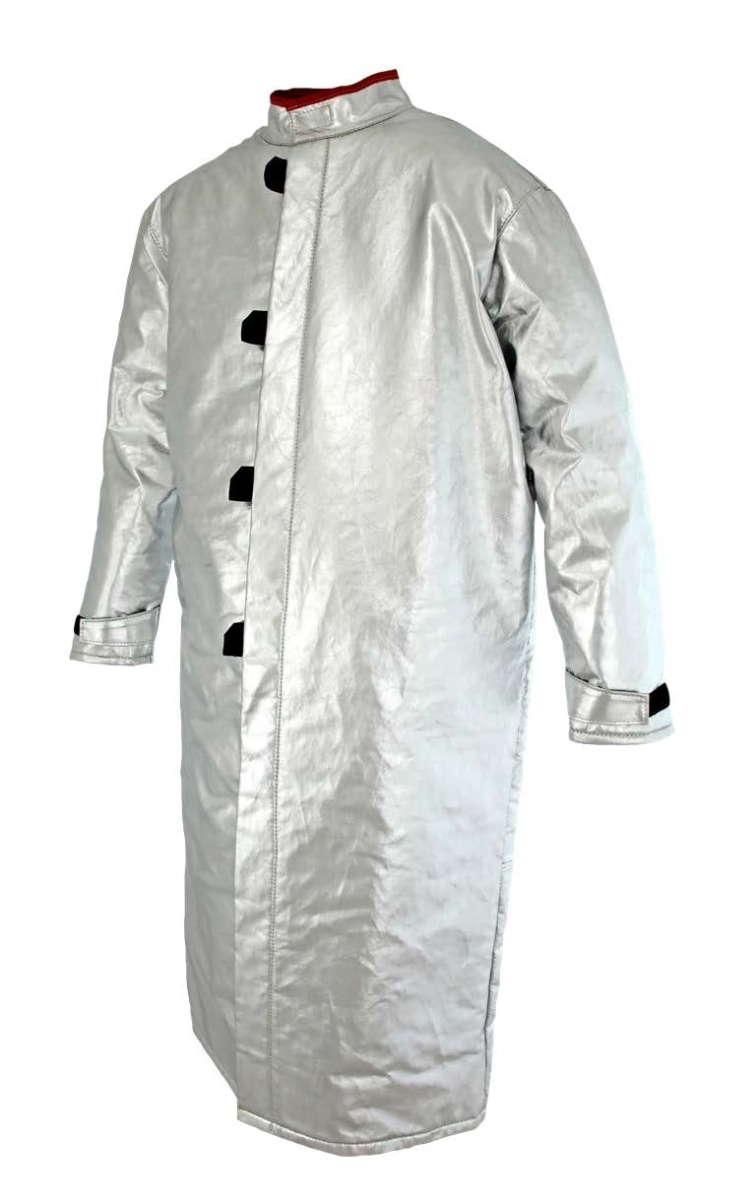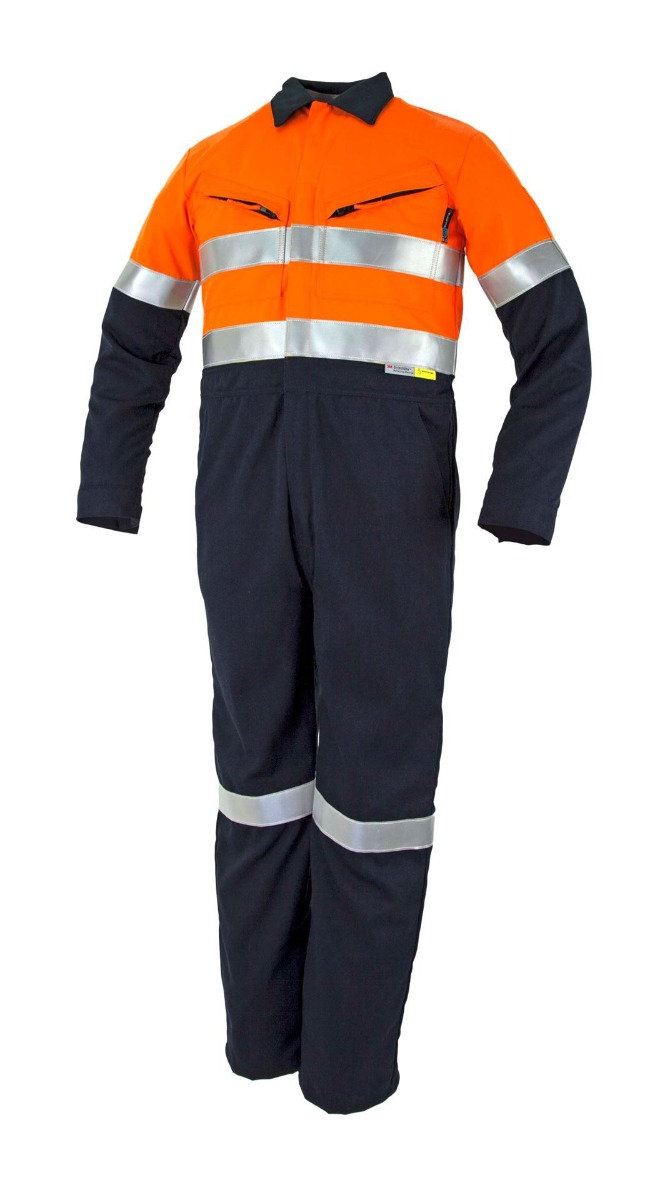Proper Protective Clothing For Foundry Work
Protective clothing used for foundry work can be categorised into two types: Primary Protective Clothing and Secondary Protective Clothing.
PRIMARY PROTECTIVE CLOTHING
Primary protective clothing is used for specific hazardous tasks and then removed. Foundry work such as charging, taping and pouring molten metal can expose workers to dangerous thermal hazards and burn injuries and primary protective clothing is the first line of defence against molten metal splash and other foundry hazards. It is the outer layer of a personal protective equipment (PPE) system. Garments such as jackets, coats, hoods, full-body approach suits, pants, coveralls, leggings, overshoes and spats can be combined to obtain the level of protection needed for the task at hand. The garments should be made from a range of specific fabrics depending on the particular hazards. There are various fabrics available many are aluminized, however, there are some non-aluminized options available.
Aluminised
Aluminised fabrics are a combination of a base fabric finished with an aluminised film or coating. They are specifically designed for protective clothing used in environments that pose serious fire risks or safety hazards associated with hot works or radiant heat sources and molten metal splash.
Non-Aluminised
There are several fabrics available that are specifically designed to provide protection from molten metal splash. Fabrics include CarbonX Repel and WeldWool.
SECONDARY PROTECTIVE CLOTHING
Secondary protective clothing is all-day or everyday clothing and is the last line of defence for the body should the primary protective clothing fails. Ideally, the clothing should be flame-resistant and the selection criteria should be based on primarily protection followed by comfort and then value. Historically heavy cotton fabrics (non-flame resistant) have been the minimum standard, however, there are now various FR Fabrics available including high-performance specialty blends for specific applications. There are two types of fire-resistant (FR) fabrics used in Secondary Protective Clothing:
Treated FR Fabrics
Treated FR fabrics are created by applying a flame-retardant chemical finish to a fabric or by adding a chemical treatment to the fibres before they are woven or knitted into the fabric. The chemicals form a strong bond with the polymer chain that is difficult to remove by washing when the recommended laundering instructions are followed accurately.
Inherent FR Fabrics
Inherent FR fabrics are made of fibres in which the FR properties are naturally part of the polymer backbone and can never be worn away or washed out. The actual structure of the fibre itself is non-flammable; therefore, the flame resistance is permanent.
Clothing Design
Clothing should be designed to withstand exposure to flame and shed molten metal quickly and effectively. Badly fitted garments can create folds that catch and hold the metal, making them less protective. The design of the garment is also important, for example, pockets and flaps create catch points, metal buttons heat up from radiant heat and reflective tape can stop the fabric breathing and cause sweat and burn marks if not placed well on a garment.
|
PRIMARY PPE for molten metal work, in addition to secondary PPE |
SECONDARY PPE for general foundry work |
|
| HEAD |
Use helmets where there is potential for items to fall from a height or where work takes place above head height, for example on a mezzanine. Industrial safety helmets should be considered. Where tasks result in dust or particulates, a head covering should be considered. |
|
| EARS | The choice of hearing protection should consider level of occupational noise, the wearer, for example personal characteristics, comfort, communication requirements, and compatibility with the job and workplace. Guidance on hearing protectors is provided in AS/NZS 1269.3 Acoustics: Hearing Conservation | |
| EYES AND FACE |
Face shields with neck protection. |
Industrial safety glasses with side shields are the minimum. |
| RESPIRATORY | The type of respirator selected should consider: the operator and physiological and psychological factors - facial hair should not be allowed; the task and how the job is done, duration, frequency; and the substance - type of contaminant, concentration. Guidance can be sourced from suppliers of respiratory protective equipment and AS/NZS 1716 Respiratory protective devices. | |
|
PRIMARY PPE for molten metal work, in addition to secondary PPE |
SECONDARY PPE for general foundry work |
|
| TRUNKS AND ARMS |
A jacket of leather or otherAluminised Foundry Jacket suitably resistant material must be worn outside other clothing. It must be free of features, for example cuffs and pockets may trap molten metal. It must be worn properly and fastened every time. |
Long-sleeved shirt madeFR Workwear - Classic Fire Resistant Long-Sleeved Shirt from flame-resistant fabric, for example wool, heavy cotton drill. Garments should fasten at the neck and wrists to prevent molten metal splashes, dust, chemicals and other substances from entering through the collar and cuffs. |
| HANDS | Heat-resistant Kevlar or heavy leather gauntlets covering the lower part of arm. | Gloves selected should take into account the: hazard, for example burns, abrasion, chemicals and cuts; work environment; and the wearer, for example fit, comfort and dexterity. Guidance on the selection, use and maintenance of protective gloves is provided in AS/NZS 2161.1 Industrial Safety Gloves and Mittens |
| LEGS |
Where risk of molten metal spills or splashesAluminised Foundry Trousers exists, trousers of leather or other suitably resistant materials must be worn. The trousers should cover the top of the footwear and be free of features, for example cuffs and pockets could trap molten metal. |
Heat-resistant trousers. |
| FEET | Workers should always wear safety footwear in the workplace, unless there are sound medical reasons, for example if wearing safety footwear would injure the wearer. In such cases, the reason for such an opinion should be given and the most effective alternative protective equipment sought. | |

